How Can We Help?
Shopify vs WordPress vs Wix: Which Is The Best Solution for Your Online Store?
The supplement industry is booming, and for good reason! People are increasingly turning to vitamins, minerals, and other nutritional supplements to support their health and well-being. If you’re a passionate entrepreneur with a vision for an online supplement store, choosing the right platform to build your empire is crucial. Three main contenders emerge: Shopify, WooCommerce, and Wix. Let’s delve into the nitty-gritty of each platform to help you pick the perfect launchpad for your supplement haven.
Know Your Vitamins: A Framework for Choosing Your Platform
Before diving in, take a moment to identify your priorities:
- Technical Expertise: Are you a coding whiz or a drag-and-drop enthusiast?
- Budget: How much can you invest upfront and for ongoing maintenance?
- Scalability: Do you dream of a bustling online store with hundreds of products, encompassing everything from essential daily vitamins to targeted sports nutrition supplements?
- Customization: How important is a unique and branded storefront experience to differentiate yourself in the crowded supplement market?
- Product Complexity: Will you be selling basic vitamins or a diverse range of specialized supplements, some of which might require intricate product descriptions and dosage recommendations?
Shopify: The All-in-One Powerhouse for Supplement Success
Shopify reigns supreme as a dedicated e-commerce platform. It offers a comprehensive solution, from setting up your store to managing inventory, payments, and shipping – perfect for streamlining your supplement business and ensuring a smooth customer experience from browsing to checkout.
Pros:
- Effortless Setup: Shopify boasts a user-friendly interface with drag-and-drop functionality. Even beginners with no coding experience can create a professional-looking supplement store that showcases your products effectively. Whether you’re focusing on essential daily multivitamins, protein powders for fitness enthusiasts, or specialized supplements for joint health or cognitive function, Shopify allows you to create a visually appealing and informative storefront that fosters trust with potential customers.
- Room to Grow: Shopify seamlessly scales with your business. Their plans cater to businesses of all sizes, from solopreneurs launching a niche protein powder store to established brands offering a comprehensive range of supplements, including general wellness products, sports nutrition essentials, and targeted solutions for specific health concerns. As your supplement store expands and attracts a wider customer base, Shopify can handle the increased traffic and product volume without compromising on performance.
- App Arsenal: The Shopify app store is a treasure trove of extensions. Find apps specifically tailored to the supplement industry, like features for showcasing product certifications, displaying dosage recommendations based on user needs (e.g., age, weight, activity level, and any potential health concerns they might have), and offering subscription services for recurring customers who rely on your supplements to maintain their health and well-being. This can help you build customer loyalty and recurring revenue streams, especially for essential daily supplements that customers tend to repurchase regularly.
- Security Matters: Shopify takes security seriously, providing robust built-in features to safeguard your store, customer data, and sensitive payment information. This is especially important considering the trust customers place in supplement brands and the potential for handling personal health data. Customers increasingly seek transparency and data security when shopping online, and Shopify‘s commitment to these aspects can give your supplement store a competitive edge.
- Hassle-Free Payments: Shopify handles payments seamlessly, eliminating the need for separate merchant accounts. This can simplify your financial management, especially during crucial launch phases when you’re focusing on building your brand and attracting customers. It also ensures a smooth checkout process for your customers, reducing friction and cart abandonment rates.
Cons:
- Customization Caveat: While Shopify offers a good range of themes, extensive design customization for a truly unique brand experience might require coding knowledge or hiring a developer. This can be a consideration if you have a strong vision for your supplement store’s aesthetic and want it to stand out from the competition.
- Cost Considerations: Shopify‘s fees can add up as your store grows, with transaction fees on top of the monthly subscription plan. Factor this into your pricing strategy for supplements, ensuring you maintain healthy profit margins.
- Limited Built-in Blogging: Shopify‘s blogging platform is basic. If content marketing is a core strategy to attract health-conscious customers, you might need a separate blogging solution to publish informative articles on various wellness topics, establish yourself as a trusted authority in the supplement space, and ultimately boost sales.
Beyond the Core Features: Supplement-Specific Considerations
Having a robust platform is essential, but for your supplement store to thrive, consider these factors specific to the supplement industry:
- Compliance Regulations: The supplement industry is heavily regulated. Ensure your chosen platform allows you to display product information clearly and accurately, following all labeling and compliance guidelines set by relevant authorities. Look for features that help you showcase product certifications and lab results, building trust with customers who are increasingly scrutinizing the quality and safety of supplements they consume. Consider integrating apps that automate tasks like label generation and compliance checks, ensuring your store adheres to all regulations and giving you peace of mind.
- Mobile-Friendly Shopping: In today’s mobile-first world, a significant portion of your customers will likely browse and purchase supplements from their smartphones. Choose a platform that prioritizes responsive design, ensuring your supplement store looks great and functions flawlessly on all devices, from desktops to tablets and smartphones. This will prevent frustration for potential customers and maximize your conversion rates. Responsive design also improves your search engine optimization (SEO), as mobile-friendliness is a major ranking factor for Google and other search engines.
- Community Building: The supplement industry thrives on fostering a sense of community. Consider the platform’s ability to integrate features like customer reviews, product ratings, and Q&A sections. This allows customers to share their experiences, ask questions, and build trust with your brand. Additionally, explore the platform’s social media integration capabilities to connect with your audience and establish yourself as a thought leader in the wellness space. Run engaging social media campaigns, host live Q&A sessions with nutrition experts, or partner with fitness influencers to spread brand awareness and attract new customers interested in your supplement range.
- Content Marketing Powerhouse: Content marketing is a powerful tool for attracting health-conscious customers and establishing your supplement store as a credible source of information. Choose a platform that allows for easy blog integration or seamlessly connects with a separate content management system (CMS) like WordPress. Regularly publish informative articles on various wellness topics relevant to your target audience. This could include debunking common supplement myths, providing guidance on choosing the right supplements for specific health goals, or offering recipe ideas that incorporate your products. Valuable content not only educates potential customers but also improves your SEO ranking in search results, driving organic traffic to your supplement store.
- Data-Driven Decisions: Data is king in the e-commerce world. Your chosen platform should provide analytics tools to track customer behavior, website traffic, and sales performance. This allows you to identify which supplements are most popular, understand your customer demographics, and measure the effectiveness of your marketing campaigns. Use these insights to optimize your product offerings, refine your target audience, and tailor your marketing strategies for maximum impact. Look for platforms that integrate with popular analytics tools like Google Analytics to gain even deeper insights into your customer base and website performance.
Shopify: A Deep Dive into Supplement-Specific Strengths
Let’s delve deeper into how Shopify caters specifically to the needs of a supplement store:
- Supplement-Specific Apps: The Shopify app store boasts a plethora of extensions designed to streamline your supplement business. Find apps for managing ingredients, displaying certifications, and even offering quizzes or assessments to help customers choose the right supplements based on their individual needs and health goals. This level of personalization can significantly enhance customer experience and boost sales.
- Inventory Management for Specialized Products: Shopify’s inventory management system can handle complex variations within a product category. This is crucial for supplements, where you might offer different dosages, potencies, or flavor options for the same core product. With clear and accurate inventory management, you can avoid stockouts and ensure a seamless customer experience.
- Marketing Muscle for Targeted Audiences: Shopify’s marketing tools and app integrations allow you to create targeted campaigns to reach specific customer segments. This is valuable for the supplement industry, where you might cater to athletes, vegans, individuals with specific health concerns, or those focused on general wellness. By tailoring your marketing messages and showcasing relevant products, you can attract a more engaged customer base and drive higher conversion rates.
Wix: The Drag-and-Drop Darling with Limitations for Supplement Stores
We’ve explored the strengths of Shopify for building a supplement store, but what about Wix? While Wix offers a user-friendly interface and beautiful design templates, it has limitations that might not be ideal for a growing supplement business. Here’s a breakdown:
Pros:
- Effortless Design: Wix excels in ease of use. Their intuitive drag-and-drop interface makes building a visually appealing storefront a breeze, even for complete beginners. This can be a major advantage if you prioritize a beautiful and modern aesthetic for your supplement store.
- Budget-Friendly: Wix pricing plans are generally more affordable than Shopify, especially for smaller stores with a limited product range. This can be attractive if you’re launching a new supplement store and have a tight budget.
Cons:
- E-commerce Limitations: Wix‘s e-commerce functionality isn’t as robust as Shopify or WooCommerce. You might encounter limitations in product management, inventory control, and advanced marketing features specifically valuable for the supplement industry. For instance, showcasing product certifications, displaying dosage recommendations based on user needs, or offering subscription services might be difficult or require complex workarounds on Wix.
- Limited Scalability: Wix stores can struggle to handle significant growth. Upgrading plans might not always translate to a smooth experience for a high-volume supplement store with a complex product catalog. Wix‘s platform might not be optimized for the specific needs of managing a large inventory of supplements and ensuring a seamless customer experience for a growing audience.
- Compliance Concerns: The supplement industry is heavily regulated. While Wix offers basic features for displaying product information, it might not provide the level of control or automation needed to ensure compliance with all labeling and safety standards. Integrating a robust compliance management solution might also be challenging on Wix.
- Content Marketing Challenges: Wix‘s built-in blogging is limited. Content marketing is crucial for attracting health-conscious customers and establishing yourself as a trusted authority in the supplement space. Wix might not offer the same level of flexibility and customization compared to platforms like Shopify that integrate seamlessly with external content management systems like WordPress.
Wix: When Might it Work for Supplements?
While Wix might not be the ideal long-term solution for a large-scale supplement store, it can be a consideration for:
- Small Supplement Startups with a Limited Product Range: If you’re launching a niche supplement store with a handful of products, Wix’s affordability and ease of use might be appealing. However, keep in mind the scalability limitations and potential compliance challenges as your business grows.
- Focus on Design Aesthetics Over Functionality: If your primary focus is on creating a beautiful and visually striking storefront with a limited product range, Wix‘s drag-and-drop interface can be a good starting point. However, prioritize clear and accurate product information to build trust with potential customers, even with a design-focused approach.
The Final Word on Wix for Supplements
Wix offers a user-friendly and affordable platform for building a website. However, for a serious supplement store, the limitations in e-commerce functionality, scalability, and compliance management can hinder your long-term growth. Carefully consider your needs and long-term vision before choosing Wix for your supplement business. Remember, a robust e-commerce platform with features tailored to the supplement industry can be a wise investment for the success of your online vitamin vault.
The Road Ahead: Choosing Your Platform Partner
The ideal platform for your supplement store hinges on your specific needs and priorities. Consider the factors outlined above, alongside your budget, technical expertise, and long-term vision. Don’t hesitate to leverage free trials offered by each platform to get a hands-on experience and see which one resonates best with your vision for your online haven of vitamins and wellness. Remember, a well-chosen platform is the foundation for a thriving supplement store. Build your dream vitamin vault wisely, and watch your business flourish in the ever-growing health and wellness market!
Creating an online store is no easy task. This guide will help you decide which ecommerce platform to choose for your online store by comparing Shopify and WooCommerce — the two most popular ecommerce platforms.
Struggling to choose between Shopify vs WooCommerce as the best place to make your ecommerce store?
There are an ever-growing number of platforms designed to help you create an ecommerce store but, if you look at the data, these two are the most popular solutions in 2024 for creating an online store. WooCommerce is in first place and powers ~30% of the stores in the BuiltWith Top 1m while Shopify is in second place and powers ~18% (with Magento in third place at ~9%).
WooCommerce is a plugin for the open-source WordPress software, while Shopify is its own standalone hosted ecommerce platform.
In general, these different approaches mean that WooCommerce gives you a lot more flexibility than Shopify, while Shopify is a bit simpler to use. But we’re getting ahead of ourselves – to learn more about where those conclusions come from, you need to keep reading our full comparison.
In this post, we’ll compare Shopify vs WooCommerce in-depth to help you choose the best ecommerce platform for your store in 2024 and beyond.
WooCommerce Overview

As you saw in the data above, WooCommerce is the most popular way to make an ecommerce store in 2024.
WooCommerce is not a standalone ecommerce platform. Instead, it’s a plugin for WordPress. If you’re not familiar with WordPress, it’s the most popular way to build a website in general, powering over 40% of all the websites on the Internet.
To launch a store with WooCommerce, you’ll first need to install the WordPress software on your web hosting. Then, you can add the WooCommerce plugin to WordPress to turn your site into a fully functioning ecommerce store.
Like WordPress, WooCommerce is a free, open-source project, which means that anyone can download, edit, or copy its code. It’s developed by Automattic — the same team behind WordPress.com and Tumblr.
WooCommerce’s standout value propositions are its flexibility and affordability. While WooCommerce itself is a plugin for WordPress, you can also find thousands of official and third-party WooCommerce plugins that further extend the core WooCommerce platform. You can use these plugins to improve your store’s shopping experience, better market your store, connect other tools and gain more control over your store.
You can also use WooCommerce themes to control how your store looks. You’ll find thousands of WooCommerce-compatible themes for a range of different niches.
If you can’t find a pre-made plugin or theme that does what you need, you also get full access to your store’s underlying code, which means you can make your own direct edits (or hire a developer to do things for you).
Overall, WooCommerce is popular because it’s free and it offers full flexibility, while also still keeping things simple enough that non-developers can use it to build a fully functioning, secure ecommerce store.
Shopify Overview

Shopify has a different approach to creating an ecommerce store than WooCommerce.
Whereas WooCommerce is an open-source project that you can install on your own web hosting, Shopify is a closed-source hosted tool.
What this means is that you don’t have access to all the code that powers your store, nor do you need to bother with hosting any software yourself. Instead, Shopify handles setting everything up for you so that you just need to register for an account and start adding products.
The main advantage of this closed-source, hosted approach is simplicity. You don’t need to install any software to create a store, nor are you responsible for maintaining or securing your store — Shopify handles all of that for you.
The tradeoff, though, is that you lose the flexibility and affordability that an open-source tool like WooCommerce offers. Instead, you’ll only have access to the specific features that the Shopify team decides to give you access to.
While there are opportunities to customize your site with apps and themes, you don’t have the failsafe of being able to directly edit your store’s code.
Additionally, Shopify can be a bit more expensive than WooCommerce, though there are a lot of variables to how much your store will actually cost.
What Should You Look for in an Ecommerce Platform?
Choosing the right ecommerce platform is essential to your store’s success. It will affect the shopping experience you create for your visitors, how streamlined your backend admin processes are, how your marketing goes, and more. It will also affect your costs, as some platforms are more expensive than others.
There’s also a fair degree of lock-in with any platform that you choose. While it is possible to migrate from Shopify to WooCommerce (or vice versa), it’s a painful, time-consuming process and you’ll often lose some data in the process.
For that reason, you’ll want to pick the right platform from day one.
When you’re choosing your platform, you need to really think about the following considerations:
- Your budget.
- The ease of use of your chosen platform.
- The features and flexibility you get access to with your platform.
- The payment gateways you’ll be able to use (especially if you need a specific local gateway).
- The integrations with third-party services for fulfillment, inventory management, accounting, etc.
We’ll focus on all these categories and more as we compare these two tools.
WooCommerce vs Shopify: A Detailed Comparison
Now, let’s get into a more detailed WooCommerce vs Shopify comparison. We’ll compare these two platforms in 14 key areas.
1. Pricing
Comparing pricing can be difficult because there are a lot of variables that go into each platform. In general, though, WooCommerce will be cheaper for most people.
There are only three things you need to launch a WooCommerce store:
- A domain name. Many hosts offer these for free, or they cost about $10 per year.
- Web Hosting. This is the most variable core cost. Small stores might be fine with $3 per month hosting, but large stores with lots of products will need more expensive hosting.
- WooCommerce. The WooCommerce software itself is free.
Those are the costs for the core ecommerce platform — but you’ll probably also want to add some third-party plugins, which might cost money. For example, if you want to access Elementor WooCommerce Builder, you’ll need to purchase Elementor Pro for $49. Other WooCommerce plugins typically cost ~$20-$80 but can range up to ~$200 for plugins such as WooCommerce Subscriptions (for recurring payments).
You also might want a premium WooCommerce theme, which usually costs ~$60.
To create a Shopify store, you only need two things:
- A domain name.
- The Shopify service.
Unlike WooCommerce, Shopify isn’t free. You’ll need to pay a recurring monthly fee for as long as your store is active – you can view the pricing plans below:
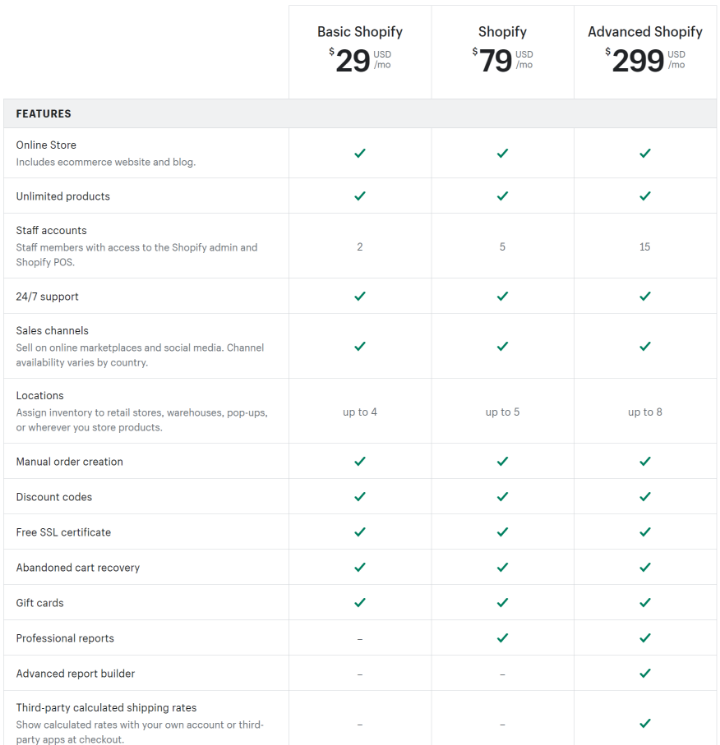
Those prices are just for the core Shopify software. You also might want to pay for premium Shopify apps, which cost anywhere from a few dollars per month to a lot more. For example, a popular SEO app costs $30 per month.
There’s an important difference in pricing between premium WooCommerce plugins vs premium Shopify apps. WooCommerce plugins are usually one-time payments, with optional renewals to keep receiving support/updates. However, Shopify apps are ongoing monthly fees, which can add up over time.
You also might want a premium Shopify theme, which typically costs ~$180 for official themes, which is about 3X what most WooCommerce themes cost.
🏆 Winner: WooCommerce. Though there are a lot of variables, WooCommerce will be cheaper for most people. WooCommerce also lets you avoid monthly recurring fees, which can really add up in the long run.
2. Ease of Use
WooCommerce is still easy enough for non-developers to use, but its setup process is a bit more technical than Shopify.
To create a WooCommerce store, you’ll need to:
- Purchase web hosting.
- Install the WordPress software.
- Install the WooCommerce plugin to WordPress.
- Go through WooCommerce’s handy setup wizard to configure your store.
Once you do that, you can manage your store via a user-friendly dashboard that looks like this:
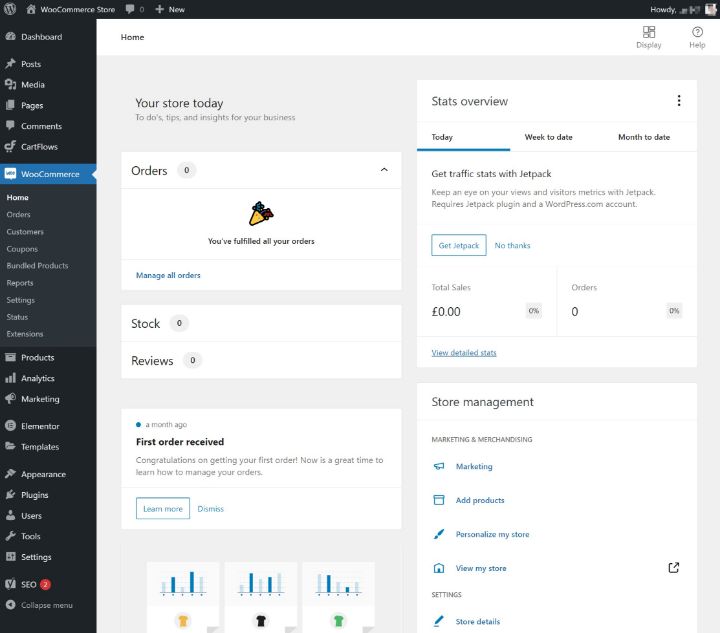
When you add a product, you’ll do so via an interface like this:
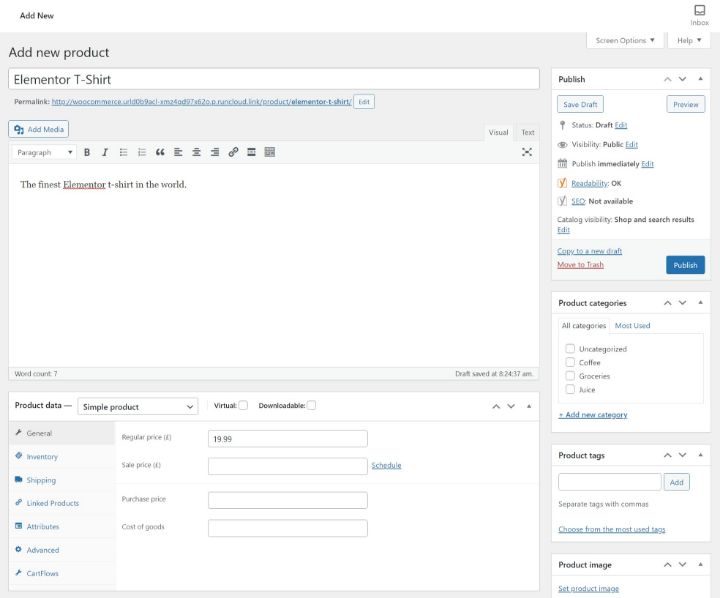
To create a Shopify store, all you need to do is register for a Shopify account and follow a simple setup wizard. Within a few minutes, you can be managing your store via a dashboard that looks like this:
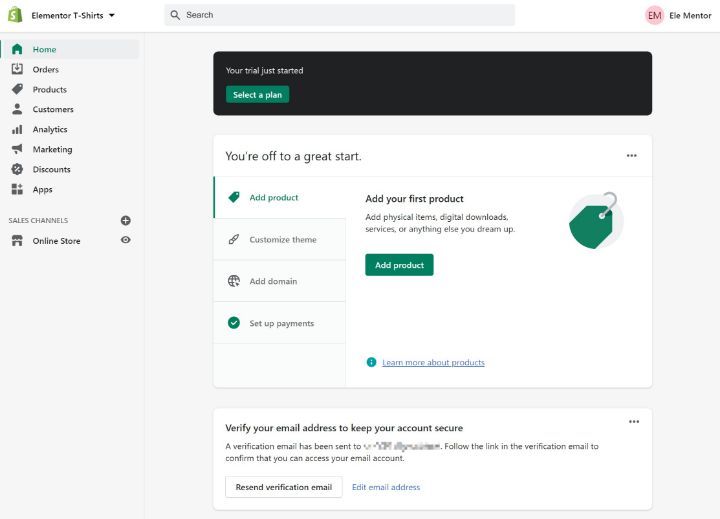
Adding a product in Shopify works pretty much the same as it does in WooCommerce:

🏆 Winner: Shopify. While WooCommerce is still accessible to non-developers, ease of use is Shopify’s most unique feature and Shopify does have the edge in that area.
3. Features & Plugins
In terms of core ecommerce features, WooCommerce and Shopify offer everything that you’d expect. Here’s a quick rundown:
| WooCommerce | Shopify | |
| Physical products | ✔️ | ✔️ |
| Variable products | ✔️ | ✔️ |
| Digital products | ✔️ | ✔️ |
| Shopping carts | ✔️ | ✔️ |
| Checkout + payment gateways | ✔️ | ✔️ |
| Coupons/discounts | ✔️ | ✔️ |
| Shipping calculations | ✔️ | ✔️ |
| Tax calculations | ✔️ | ✔️ |
| Order management | ✔️ | ✔️ |
| Customer management | ✔️ | ✔️ |
| Reports | ✔️ | ✔️ |
| Mobile app | ✔️ | ✔️ |
Where they differ is in adding features beyond that, which you’ll typically do via third-party extensions:
- WooCommerce calls these “plugins”.
- Shopify calls these “apps”.
For WordPress and WooCommerce, you’ll find 58,000+ free plugins at WordPress.org and thousands more premium plugins at other marketplaces like CodeCanyon. Not all of those plugins are focused on ecommerce, but the point is that you have a lot of flexibility.
For Shopify, you’ll find 5,700+ apps, which also gives you a lot of flexibility, though it’s well below what WordPress and WooCommerce offer.
🏆 Winner: WooCommerce. While both platforms give you all the core features you need to make an ecommerce store, WooCommerce has a larger collection of add-ons and direct code access for customizations.
4. Payment Methods
WooCommerce gives you a lot of ways to work with payments. First off, it offers its own official WooCommerce Payments service that’s powered by Stripe. However, the official service is only available to US-based merchants at the time that we’re writing this comparison.
Beyond that, WooCommerce lets you integrate with hundreds of additional gateways using plugins. You’ll find official integration plugins for big names such as Stripe, PayPal, and Authorize.net, but you can also find lots of third-party extensions for smaller payment gateways, including local providers.
In addition to debit and credit card payments, WooCommerce also makes it easy to accept alternative payment options, i.e. cryptocurrency, cash on delivery, checks, and more.
Shopify handles payments a little differently. Shopify offers its own Shopify Payments service that’s enabled by default and Shopify heavily “encourages” you to use this default option. You can use a different gateway, but Shopify will charge you an extra fee on top of the regular processing fee from your provider. This fee starts at 2% and goes down to 0.50% on the highest-tier plan.
If you’re willing to pay that fee, Shopify supports hundreds of additional gateways – full list here.
Shopify does support manual payments (cash or check) with no transaction fee. You can also access additional options, like cryptocurrency, via third-party gateways (such as Coinbase Commerce).
| WooCommerce | Shopify | |
| Built-in Payment Solution | ✔️ | ✔️ |
| Third-Party Gateways | 100+ | 100+ |
| Extra Fee for Third-Party Gateways | No extra fee | 2.0% (or 1%/0.50%) |
🏆 Winner: WooCommerce. Both tools support lots of large and small payment gateways, but WooCommerce wins because it doesn’t charge an extra fee for using third-party payment gateways.
5. Customizability and Design Options
There are two main ways that you can customize the design of your WooCommerce store:
- Themes
- Plugins
Once you install a WooCommerce theme, you’ll typically be able to customize it using a code-free real-time editor that looks like this:

If you want to go beyond the options that your WooCommerce theme offers, you can also install a design plugin. For example, if you use Elementor Pro, you’ll get access to Elementor WooCommerce Builder, which lets you design your store’s shop and product pages using a visual, drag-and-drop interface for pixel-perfect control. You can also use it to build popups for your store.
Shopify offers the same basic approach to design customization, you just don’t get quite as much flexibility as WooCommerce.
You can start with a basic Shopify theme and customize it using Shopify’s design editor, which offers a sort of block-based builder, though you can’t use drag-and-drop on the actual preview of your store (only in the sidebar):
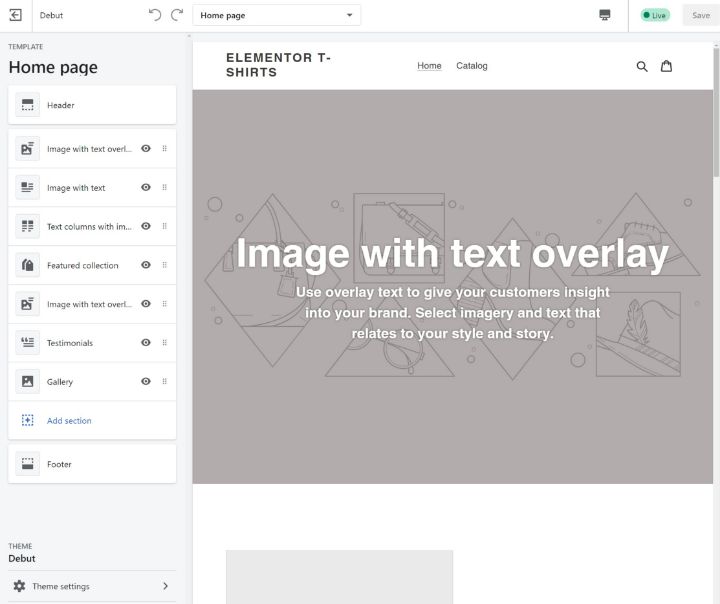
For more flexibility, you can also find some Shopify builder apps that let you customize your product pages or create popups. However, you don’t get the same level of design flexibility that something like Elementor WooCommerce Builder offers. So far, PageFly seems to be a good alternative for a drag and drop builder for Shopify.
🏆 Winner: WooCommerce. While Shopify does offer a similar approach, WooCommerce gives you more flexibility.
6. Operating and Maintenance Issues and Costs
If you use WooCommerce, you’ll be responsible for maintaining your store, which mainly consists of updating the WooCommerce core software and extensions. Updating is simple – you just click a few buttons. However, there can sometimes be compatibility issues, so you usually want to be careful and safely update your store by using a staging site.
You’ll also need to make sure you’re making regular backups, which you can do with plugins such as BlogVault or Jetpack Backup.
If you don’t want to do this yourself, you can pay for a type of hosting called managed WordPress hosting (typically starts at $30 per month) or you can pay for a WordPress maintenance service (WooCommerce-focused services usually cost $100-$150 per month).
With Shopify, you don’t need to worry about maintaining the Shopify software because Shopify handles everything for you.
In terms of backups for Shopify, you’ll probably want to pay for a Shopify app like Rewind Backups to make sure you always have a copy of your store’s data. This costs anywhere from $3-$99 per month, depending on your store, so Shopify maintenance costs can also add up even though Shopify handles updates for you.
🏆 Winner: Shopify. One of the perks of Shopify is that it handles a lot of the maintenance for you. With WooCommerce, you’ll need to handle updates and such yourself (or pay for someone to do it for you). However, Shopify backups are more expensive than WooCommerce, which is something to consider when it comes to budgeting.
7. Scalability
Scalability refers to the ability of your ecommerce platform to handle large numbers of products and/or high-traffic situations.
Both platforms can scale to handle large stores, though WooCommerce might require a little more technical expertise to scale.
🏆 Winner: It’s a tie. Both WooCommerce and Shopify can scale to handle large stores with lots of products.
8. Support Options
Because WooCommerce is a free, open-source project, you don’t get direct access to dedicated support reps like you would with a paid service. Instead, you’ll need to rely on community support. Thankfully, because WooCommerce and WordPress are so popular, it’s pretty easy to find help.
Additionally, if you purchase premium extensions, you’ll get support directly from the developer. For example, if you purchase Elementor Pro for Elementor WooCommerce Builder, you’ll get support directly from the Elementor team.
As a paid service, your Shopify subscription gets you access to direct support from Shopify staff, such as live chat, which is a nice perk. For third-party Shopify apps, you’d need to get support directly from the developer of the app.
🏆 Winner: Shopify has the edge because of its direct support channels. However, it’s still pretty easy to get help with WooCommerce thanks to community support.
9. Multilingual Capabilities
WordPress and WooCommerce are very multilingual-friendly. You can find several popular plugins to translate your store into unlimited languages, including full localization and currency switchers. Some good options for WooCommerce are:
Shopify includes a feature to let you create your store in up to five languages. You can manually add your translations, or you can use a third-party translation app to help you generate the translations.
🏆 Winner: WooCommerce. WooCommerce lets you use unlimited languages and also gives you more flexibility for managing translations.
10. Tax Settings
Both Shopify and WooCommerce include tools to help you collect accurate tax rates.
WooCommerce offers its own free WooCommerce Taxes service to automatically calculate accurate tax rates. This service supports over 30+ countries, including the USA and most of Europe.
WooCommerce also includes some built-in settings, as well as support for third-party solutions such as Avalara and TaxJar.
Shopify includes built-in tax configurations for the USA and Canada, along with the option to set up custom tax overrides for various regions. As with WooCommerce, you can also use Shopify apps to connect to TaxJar or Avalara.
🏆 Winner: It’s a tie. Both platforms are pretty flexible and both give you options to automate tax calculations.
11. Shipping Configurations and Costs
Both WooCommerce and Shopify offer flexible shipping options via built-in features or, more likely, third-party add-ons and integrations.
| WooCommerce | Shopify | |
| Shipping classes | ✔️ | ✔️ |
| Shipping zones | ✔️ | ✔️ |
| Table rate shipping | ✔️ | ✔️ |
| Real-time USPS rates | ✔️ | ✔️ |
| Real-time FedEx rates | ✔️ | ✔️ |
| Free shipping | ✔️ | ✔️ |
| Pickup & local delivery | ✔️ | ✔️ |
🏆 Winner: It’s a tie. Both platforms give you a lot of flexibility for custom shipping calculations.
12. Page Speed and Performance
Both WooCommerce and Shopify give you the tools to create a fast-loading store.
With WooCommerce, you’ll be responsible for optimizing your store. This includes choosing good hosting, setting up a content delivery network (CDN), etc. As long as you invest in optimal hosting, you can make your store load very quickly.
Shopify handles hosting for you, so you’ll need to trust its performance optimization. It also builds in a CDN to improve global load times.
🏆 Winner: It’s a tie. You can create a fast-loading store with both platforms.
13. SEO Capabilities
SEO is obviously essential for any ecommerce store because organic traffic will play a big role in your store’s success.
With both platforms, you’ll likely end up relying on third-party apps to give you more control over your store’s SEO.
WordPress/WooCommerce has a number of popular free and paid SEO plugins such as:
- Yoast SEO
- Rank Math
- All-In-One SEO
- The SEO Framework
- SEOPress
Many stores will be fine with a free plugin and even the paid plugins are pretty affordable.
WooCommerce also gives you more control over nitty-gritty SEO details, such as your site’s URL structure.
With Shopify, you’ll also want a third-party SEO app if you’re serious about your store’s optimization. However, you don’t get quite as many options as WooCommerce and the apps can be pretty expensive. For example, SEO Booster, the most popular Shopify SEO app, costs a whopping $30 per month for its premium versions whereas most WordPress SEO plugins are more like $60 per year.
Additionally, Shopify doesn’t offer as much control over URLs. For example, you have to use the default URL structure for your blog on Shopify, which a lot of people don’t like. This is an area where WooCommerce is stronger.
🏆 Winner: WooCommerce. WooCommerce gives you more options for SEO extensions and its plugins are more affordable. It’s also more flexible when it comes to things like URL structures.
14. Security
Both WooCommerce and Shopify are secure.
WooCommerce is built on WordPress, the security of which is trusted by big organizations as diverse as the US White House and Facebook. The WooCommerce core software is also rock-solid and, because it’s open-source, benefits from the analysis of a large open-source community in addition to the Automattic team.
Shopify has also done very well when it comes to security, though it’s not an open-source project so it’s not quite as transparent. There have been no major breaches in Shopify’s history, so you can also be confident in the security of your Shopify store.
Overall, both platforms are secure, though WooCommerce requires a little more vigilance to maintain security (such as making sure to promptly apply software updates).
🏆 Winner: It’s a tie because both platforms are secure. However, Shopify is a little more hands-off when it comes to security, which some people might prefer.
WooCommerce vs Shopify: Which One Should You Choose?
To quickly recap, here’s a table comparing the winners of the sections we compared above:
| WooCommerce | Shopify | |
| Pricing | 🏆 | – |
| Ease of use | – | 🏆 |
| Features & extensions | 🏆 | – |
| Payment methods | 🏆 | – |
| Customizability & design | 🏆 | – |
| Maintenance | – | 🏆 |
| Scalability | 🏆 | 🏆 |
| Support | – | 🏆 |
| Multilingual capabilities | 🏆 | – |
| Tax settings | 🏆 | 🏆 |
| Shipping configurations | 🏆 | 🏆 |
| Page speed | 🏆 | 🏆 |
| SEO capabilities | 🏆 | – |
| Security | 🏆 | 🏆 |
Now for the important question – should you use WooCommerce or Shopify?
As we compared Shopify vs WooCommerce in detail in the sections above, you can hopefully see the themes that we set up for you at the beginning play out.
That is, WooCommerce excels when it comes to flexibility and features, while Shopify has the edge when it comes to simplicity because Shopify handles a lot of the basic setup and maintenance for you.
But here’s the important thing:
There are ways to make WooCommerce simpler and more hands-off, but there aren’t many ways to add more flexibility to Shopify beyond its pre-built apps. This is one of the big reasons why WooCommerce is a better option for most people and also why WooCommerce is leading Shopify in terms of market share.
Beyond that, you can also use WooCommerce’s open nature to make it more beginner-friendly. For example, if you feel overwhelmed by designing your store, you can leverage Elementor WooCommerce Builder to design your store using a visual drag-and-drop interface, which removes code from the equation.
Or, if you feel overwhelmed by maintaining WooCommerce yourself, you could always use managed WordPress hosting providers or hire a WordPress maintenance service.
WooCommerce’s open-source nature also can make it a lot cheaper. WooCommerce itself is free, as compared to Shopify’s recurring monthly fees.
If you’ve decided that WooCommerce is the best place for your store, we have some great resources to get you started. You can follow our guide to building an ecommerce website or our complete WooCommerce tutorial. Once you have your store up and running, you can also follow our guide to customize the WooCommerce product page design using Elementor WooCommerce Builder and prebuilt ecommerce templates.
Do you still have any questions about choosing between WooCommerce vs Shopify vs Wix? Get in touch with us and we’ll show you around WooCommerce, Shopify and Wix.

